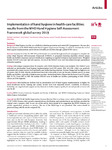2022-02-23Zeitschriftenartikel
Implementation of hand hygiene in health-care facilities: results from the WHO Hand Hygiene Self-Assessment Framework global survey 2019
de Kraker, Marlieke E. A.
Tartari, Ermira
Tomczyk, Sara
Twyman, Anthony
Francioli, Laurent C.
Cassini, Alessandro
Allegranzi, Benedetta
Pittet, Didier
Background
Hand hygiene is at the core of effective infection prevention and control (IPC) programmes. 10 years after the development of the WHO Multimodal Hand Hygiene Improvement Strategy, we aimed to ascertain the level of hand hygiene implementation and its drivers in health-care facilities through a global WHO survey.
Methods
From Jan 16 to Dec 31, 2019, IPC professionals were invited through email and campaigns to complete the online Hand Hygiene Self-Assessment Framework (HHSAF). A geospatial clustering algorithm selected unique health-care facilities responses and post-stratification weighting was applied to improve representativeness. Weighted median HHSAF scores and IQR were reported. Drivers of the HHSAF score were determined through a generalised estimation equation.
Findings
3206 unique responses from 90 countries (46% WHO Member States) were included. The HHSAF score indicated an intermediate hand hygiene implementation level (350 points, IQR 248–430), which was positively associated with country income level and health-care facility funding structure. System Change had the highest score (85 points, IQR 55–100), whereby alcohol-based hand rub at the point of care has become standard practice in many health-care facilities, especially in high-income countries. Institutional Safety Climate had the lowest score (55 points, IQR 35–75). From 2015 to 2019, the median HHSAF score in health-care facilities participating in both HHSAF surveys (n=190) stagnated.
Interpretation
Most health-care facilities had an intermediate level of hand hygiene implementation or higher, for which health-care facility funding and country income level were important drivers. Availability of resources, leadership, and organisational support are key elements to further improve quality of care and provide access to safe care for all.
Dateien zu dieser Publikation

